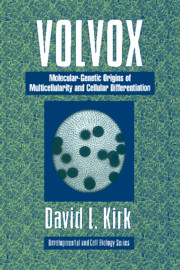 Volvox
Volvox Book contents
- Frontmatter
- Contents
- Preface
- Prologue
- 1 Introduction
- 2 The Volvocales: Many Multicellular Innovations
- 3 Ecological Factors Fostering the Evolution of Volvox
- 4 Cytological Features Fostering the Evolution of Volvox
- 5 Volvox carteri: A Rosetta Stone for Deciphering the Origins of Cytodifferentiation
- 6 Mutational Analysis of the V. carteri Developmental Program
- 7 Molecular Analysis of V. carteri Genes and Development
- Epilogue
- References
- Index
4 - Cytological Features Fostering the Evolution of Volvox
Published online by Cambridge University Press: 16 December 2009
- Frontmatter
- Contents
- Preface
- Prologue
- 1 Introduction
- 2 The Volvocales: Many Multicellular Innovations
- 3 Ecological Factors Fostering the Evolution of Volvox
- 4 Cytological Features Fostering the Evolution of Volvox
- 5 Volvox carteri: A Rosetta Stone for Deciphering the Origins of Cytodifferentiation
- 6 Mutational Analysis of the V. carteri Developmental Program
- 7 Molecular Analysis of V. carteri Genes and Development
- Epilogue
- References
- Index
Summary
In flagellated cells of green algae the flagellar apparatus is structurally connected to all major organelles. Most often the connection is provided by flagellar roots. … microtubular flagellar roots … determine the position of cell organelles with respect to the flagellar apparatus and … the plane of beat of the flagella. In some cases ([e.g. the] eyespot …) the positional relationship may be necessary for proper function, in others it may be necessary to ensure correct distribution of … organelles during cytokinesis.
Melkonian (1984b)There is a widespread belief that “developmental constraints” serve as boundary conditions that limit the types of morphological innovations that can arise within any group of organisms (Alberch 1982; Maynard Smith et al. 1985), though there is less than universal agreement about how developmental constraints are to be defined and recognized. The basic concept is that the range of morphological innovations that can be generated within any group of organisms is constrained by certain fundamental features of the cellular organization and developmental biology of that group of organisms.
The hypothesis to be developed in this chapter is that the extraordinary degree to which organelles within a green flagellate cell are interconnected by a highly regular cytoskeletal network, as outlined in the foregoing quotation, constitutes a fundamentally important developmental constraint that (when combined with the presence of a coherent cell wall and the selective pressures discussed in the preceding chapter) led, with a certain degree of inevitability, to the appearance of organisms, like Volvox, with a division of labor between somatic and reproductive cells.
- Type
- Chapter
- Information
- VolvoxA Search for the Molecular and Genetic Origins of Multicellularity and Cellular Differentiation, pp. 68 - 108Publisher: Cambridge University PressPrint publication year: 1997


